There are only a few photographic pictures of St. George’s during the Civil War. However, those we have show a young church less than 15 years old. The next pictures would not be taken until 40 years later after George Eastman had developed transparent roll film and the roll holder that made photography easier and more accessible. The photographs we have are the product of Timothy O’Sullivan, James Gardner and A. J. Russell.
- Timothy O’Sullivan from Falmouth, March, 1863
O’Sullivan was born in New York City around 1840. As a teenager, he was employed by Mathew Brady. When the Civil War began in early 1861, he was commissioned a first lieutenant in the Union Army and, over the next year, fought in Beaufort, Port Royal, Fort Walker, and Fort Pulaski. After being honorably discharged, he rejoined Brady’s team. In July 1862, O’Sullivan followed the campaign of Maj. Gen. John Pope’s Northern Virginia Campaign. He is most famous for his Gettysburg pictures. After the war from 1867 to 1869, he was official photographer on the United States and took dramatic pictures of the West. He died in 1881 of tuberculosis.
O’Sullivan’s pictures were taken on the Union side in Falmouth and show both sides of St. George’s:


Recently, the Library of Congress has digitized his photographs and using computer photography programs we can see many of the details missing since that time. The south side photo on the left show a Church in May 1863, naked without paint, with the original diamond pane windows. It appears the right part of the louvers is out at the bell level (above the clock) on the south side and possibly one on the east side. One slat on the top louver is out on the south side and two on the east side. Most photos do not show a front view. The north side to the right is not as clear but appears to show window #10 all the way to the left covered over. There is no northeast transept which was added in 1925.
- Church from Sandy Bottom
This famous photo was taken at the junction of Hanover and Maury. The damaged properties would be in the Maury field area. The right picture is an enhanced close-up. This is possibly the only front side picture of the Church available. It shows the louvers at the top and bell levels. The latter appears different in shape from the one today.
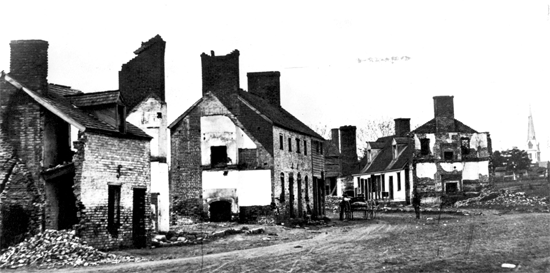
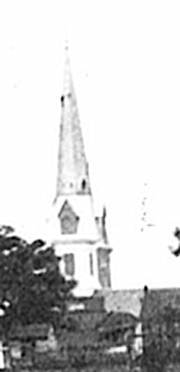
- James Gardner, 1864 – Princess Anne Street
The one on the left, below, was taken from near the Methodist Church on Princess Anne Street, is dated 1861-1869 but is likely to be May, 1864. The four spheres at the top of the steeple spire are no longer present and a weathervane may be on top rather than the cross now there. Historian Quenzel in The History and Background of St George’s Episcopal Church, Fredericksburg, Virginia stated that a gilded copper cross was added to the spire 1906-1909 due to the decayed condition of its supports.
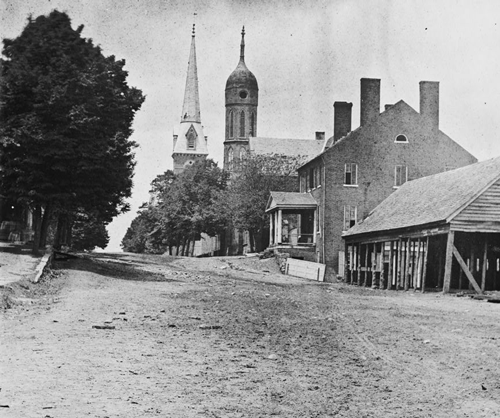
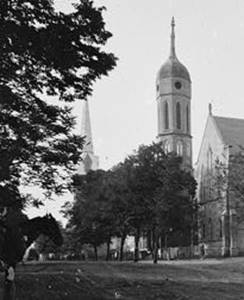
The spheres disappeared at the same time. The band just above the four dormers of louvers still exists. There is one unknown detail above this band that is not present today.
The “eye” just beneath the spire is the top of the uppermost opening of louvers in the brick tower, the entire opening having a mullion forming two lancets with tracery at top forming arched tops for the lancets, and a roundel above them, all being within the arched masonry opening; a very typical Italian Romanesque or Italianate style window.
The one on the right , cropped from a larger one that is dated May 19, 1864, was presumably taken at the same time as the Battle of Spotsylvania. Note the horse on the left of the picture. Visible in the distance is the grave yard wall, the earliest photographic view. At the time the Church was used an evacuation hospital.
- A. J. Russell, May, 1863
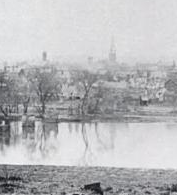
Andrew J. Russell was born on March 20, 1829 in Walpole, New Hampshire. He grew up in New York, where his family worked in canal and railroad construction. He originally worked as a painter. In August, 1862, he enlisted in the 141st NY regiment and assigned to the defenses around Washington D. C. and then transferred to Belle Plains. Then he was assigned to General Haupt to work as a photographer for the United States Military Railroad. After the war he was hired by the Union Pacific Railroad and captured the famous photograph of the joining of the rails at Promontory Point, Utah.
The photographs previously displayed show the Church in times other than battle. At the early point in the Battle of Chancellorsville, May 3, 1863 the so-called “Second Battle of Fredericksburg” occurred sweeping the confederates off of Marye’s Heights. Russell mounted his camera at a lower part of the Stafford heights and in a photograph labeled “Battle Progressing” captures the smoke from that date literally wrapped around St. George’s.
- Paintings, Sketches

Edwin Forbes (1839-1895) began as animal and landscape painter and was known for his detailed rendering of Civil War subjects such as Fredericksburg during the Federal occupation in May, 1862 shown on the left. This would have been the Fredericksburg that both Presidents Lincoln and Davis would have seen.

Alfred Waub (1828-1861) born in England and emigrated this country to become an illustrator for magazines and books. He was a correspondent during the Civil War for the New York Illustrated News. He provided detailed sketches in the field, which were then rushed by courier back to the main office of the newspaper they were working for. There a staff of engravers would use the sketches create engravings on blocks of boxwood. This was an alternate to photographs which could not show action at the time due to long exposure times. The picture at left was done at the time of the Battle of Fredericksburg in December, 1862
